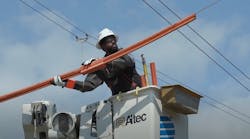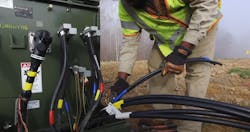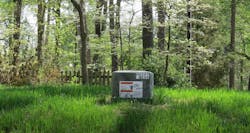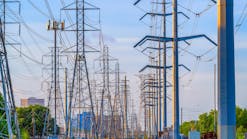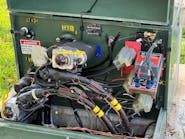Dominion Undergrounds 1800 Miles and Counting
Fewer things in life are more frustrating than being without electricity. When the power is out, lives are halted. People cannot access the internet, charge their cell phones, heat or cool their homes, or even prepare meals. Almost every aspect of life is reliant on electricity.
Nearly 1 million customers of Dominion Energy experienced how true this is on June 29, 2012, when a straight-line wind thunderstorm swept through the utility’s service area and knocked out their power. It took more than eight days and thousands of employees and contractor resources to restore power.
In the following days, Dominion examined the data and number of overhead lines that service its customers. The utility discovered a common element: tap lines that are the most outage prone. If it could put a percentage of these lines underground, power could be restored more quickly. Customers could get back to their lives faster and reliability could be improved. With this in mind, the utility’s strategic underground program (SUP) was born.
All About SUP
Dominion’s SUP is a reliability initiative aimed at replacing the most outage-prone overhead electric distribution lines with cost-effective underground lines. Burying these tap lines, which serve neighborhoods and homes, reduces the number of repairs needed for service restoration following a major storm. This benefits all customers, even those whose lines remain overhead. Why? Because there are fewer lines to repair and fewer repairs to individual properties, enabling line crews to focus on other outages, so power can be restored more quickly for everyone.
Ennis continued, “Over the years, I have been very impressed with what our crews and their equipment have been able to accomplish. Furthermore, by using Dominion’s award-winning augmented reality application, the customer can even visualize what a padmounted transformer or pedestal would look like on their property!”
Dominion’s crews perform the undergrounding work through directional drilling and potholing. When underground construction is complete, they perform pole topping.
Directional Drilling
Directional drills are used rather than open trenching to minimize disruption to landscaping. SUP teams work with property owners to determine an acceptable placement of underground facilities.
This type of drill provides a low-impact way to install conduit and cables horizontally underground. A construction hole is used as an entrance point for the drill, which can travel up to 500 ft (152 m) from the single entrance hole. To ensure safe installation of the underground lines, crews work with one-call underground damage prevention services, to identify any underground public utilities (that is, water, sewer and gas).
Potholing
In cases where the underground cable will cross other utilities, smaller safety holes are hand dug. This practice, a term called “potholing,” is required because the safety holes expose the other underground utilities and ensure the drill has enough clearance to pull the new underground electric cable through safely.
The location of each padmounted transformer is determined by the electric load calculations and route of the underground lines. In some cases, a meter base adapter is needed at the customer’s home to accept cables from underground.
Effective Planning
The time required to complete an individual undergrounding project can vary based on many factors. In the case of a large subdivision project, it can take many months as Dominion works to obtain easements, educate customers, and install the underground cable and equipment. In the case of smaller communities, work potentially can be completed more quickly.
Property owners are notified in advance when an outage is scheduled to make any necessary adjustments. An outage to make the final conversion from overhead service to underground service typically lasts four hours or less, and power supply equipment is offered to customers who express a need to stay connected during that time.
Pole Topping
Once all underground construction is complete and the new lines are connected at pedestals, Dominion removes any overhead electric lines and equipment from the poles. Dominion also may top the pole, meaning crews will remove unneeded pole height. This decision is determined by the owner of the pole going forward.
If Dominion remains the pole owner, then the unneeded pole height will be removed. If a telecommunications company becomes the pole owner, Dominion defers to the new pole owner on whether to remove any unneeded pole height. The new pole owner applies their standards to ensure safe and effective operation of the pole line.
Bottom Line
During the last five years, more than 1800 miles (2897 km) of overhead tap lines have been converted to underground through the SUP. Because the program is spread so extensively throughout Dominion’s service area, both Dominion and contract employees are involved in all aspects of the program, including project management, design, right-of-way, communications, installation, removal of equipment and property restoration. Additionally, each project has a dedicated Dominion point of contact.
Dominion continues to focus on undergrounding the most outage-prone overhead tap lines within its service area. The utility is proud to give more peace of mind to its customers, so that when a major storm hits, they can enjoy faster restoration times and, in some cases, no outage at all.
Heather Montville is communications manager for Dominion Energy’s strategic underground program (SUP), developing and overseeing the program’s award-winning communication efforts within the utility’s Virginia and North Carolina service territories. Customer communication is the backbone of SUP. Montville and her team are constantly looking for new and innovative ways to improve the process as the program continues to grow. With a bachelor’s degree in business and a master’s
degree in marketing, Montville finds excitement in diving into new opportunities to create innovative processes in this ever-expanding program.
Julia Mathers ([email protected]) is a marketing and communications coordinator for the strategic underground program (SUP), with 15 years of energy experience working within the Dominion Energy Virginia Distribution organization. As part of the SUP, Mathers partners with the utility’s authorized construction contractors to give an organic customer service experience. By using the program’s augmented reality app, Mathers can give customer a visual of how the new underground facilities will look in their yard. Mather’s bachelor’s degree in English has inspired her to communicate with customers whether it be written, verbal or just through a smile.
